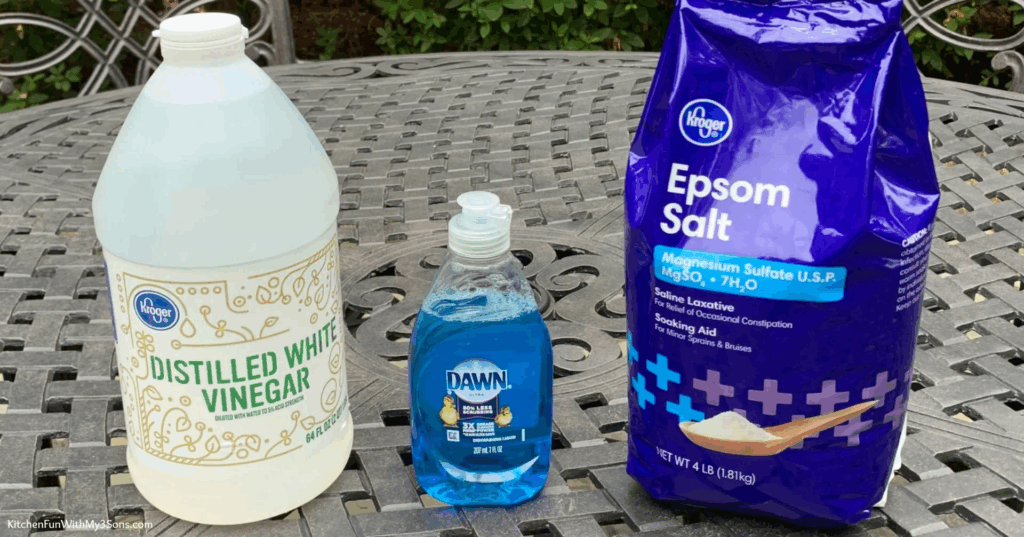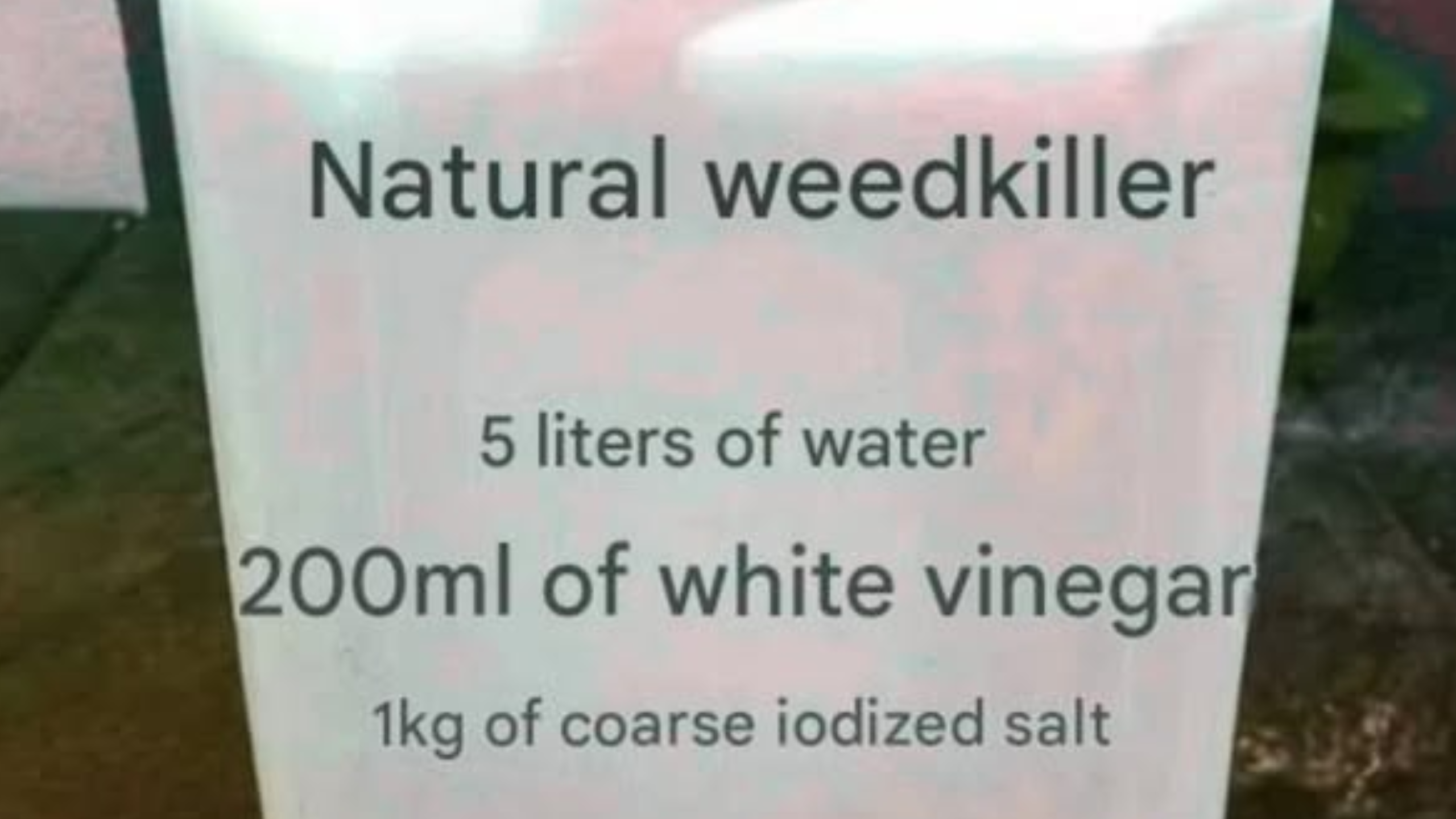Looking for a natural way to kill weeds without using harsh chemicals? Whether you’re maintaining a home garden, tidying up your driveway, or keeping walkways clear, this DIY weed killer is a powerful solution using just three simple household ingredients. It’s cost-effective, environmentally friendly, and easy to prepare in minutes.
Let’s break down how it works, how to make it, and what to watch out for when using it.
Why Choose a Natural Weed Killer?
Commercial weed killers often contain toxic substances that can harm pets, children, and pollinators like bees. They can also seep into the soil, affecting nearby plants and the environment.
By choosing a natural weed killer, you:
- Reduce exposure to harmful chemicals
- Save money with ingredients you likely already have
- Gain control over what you’re applying to your soil
- Create a safer space for family and pets
The Ingredients You’ll Need 🧂🍋💧
To prepare this homemade weed killer, gather the following:

- 5 liters of water 💧
- 200 ml of white vinegar (5% acidity) 🍋
- 1 kg of coarse iodized salt 🧂
These ingredients work in synergy:
- Vinegar is acidic and damages plant cells.
- Salt dehydrates the plant and alters the soil to prevent regrowth.
- Water helps distribute the mixture evenly and ensures it penetrates to the roots.
How to Mix and Apply
Step 1: Combine the ingredients
In a large container (such as a garden sprayer or bucket), pour in the water first. Slowly add the salt and stir until fully dissolved. Then add the vinegar and mix thoroughly.
Step 2: Pour or spray the mixture
Using a spray bottle or a pump sprayer, apply the solution directly onto the leaves and base of the weeds. For best results:
- Apply on a dry, sunny day
- Ensure the weed leaves are fully covered
- Avoid watering the area for at least 24 hours after application
Step 3: Monitor and reapply if needed
Within a few hours, you should begin to see the weeds turning brown and wilting. Persistent or deep-rooted weeds may require a second application after a few days.
Where to Use (and Where Not To)
This mixture is non-selective, meaning it will kill or damage any plant it touches. Use it carefully in the following areas:
✅ Cracks in driveways or pavements
✅ Along garden borders (away from desired plants)
✅ Gravel paths or patios
✅ Under fences
Avoid spraying on lawns, flower beds, or near vegetable gardens unless you are targeting only the weeds and can avoid contact with other plants. Salt can build up in the soil and make it unsuitable for plant growth over time.
How Often Should You Apply It?
This natural weed killer works best for small, emerging weeds. Heavily infested areas or well-established plants may require multiple treatments or additional methods like hand-pulling. For prevention, reapply monthly in problem areas during peak weed seasons (spring and summer).
Tips for Best Results
- Use warm water to help dissolve the salt faster.
- Shake or stir before each use to ensure ingredients stay mixed.
- Label your container and keep it out of reach of children or pets.
- Avoid rainy days as rain can dilute the solution and reduce its effectiveness.
A Word of Caution
While this solution is safer than many chemical options, it still alters your soil. Repeated use in the same area can make it difficult for anything—including grass or flowers—to grow later. Always test a small area first if you’re unsure.
Also, be cautious when disposing of excess solution. Avoid dumping large amounts in garden beds or near trees you want to keep healthy.
Final Thoughts
This natural weed killer is a simple yet effective way to manage weeds without compromising safety or sustainability. With ingredients you probably already have at home, you can mix up a batch in minutes and take control of unwanted growth naturally.
Whether you’re maintaining a neat garden path or reclaiming space from invasive plants, this homemade solution gives you a powerful, eco-friendly option that really works. 🌱
Try it out and enjoy a cleaner, greener yard—without the chemicals!


amoxil pills – buy generic amoxil online cheap amoxicillin tablets
forcan cost – buy fluconazole 100mg without prescription forcan usa
order cenforce 50mg generic – https://cenforcers.com/# cenforce 100mg ca
sildenafil vs tadalafil vs vardenafil – https://ciltadgn.com/ cialis from canada
does cialis make you last longer in bed – https://strongtadafl.com/# tadalafil and sildenafil taken together
buy viagra glasgow – https://strongvpls.com/# viagra 50mg price walmart
This is the stripe of content I have reading. click
I am in fact enchant‚e ‘ to glitter at this blog posts which consists of tons of useful facts, thanks representing providing such data. generic amoxicillin
More posts like this would make the online play more useful. https://ursxdol.com/amoxicillin-antibiotic/
This is the description of glad I enjoy reading. purchase atenolol sale
More posts like this would add up to the online elbow-room more useful. cialis super active generique prix
The thoroughness in this break down is noteworthy. https://ondactone.com/spironolactone/
I couldn’t resist commenting. Profoundly written!
buy celebrex
More peace pieces like this would make the интернет better. http://iawbs.com/home.php?mod=space&uid=915039
dapagliflozin 10mg for sale – janozin.com forxiga 10mg canada
buy orlistat generic – buy orlistat pills for sale xenical price
More articles like this would frame the blogosphere richer. http://3ak.cn/home.php?mod=space&uid=230401
You can conserve yourself and your ancestors by way of being cautious when buying panacea online. Some pharmaceutics websites control legally and sell convenience, secretiveness, rate savings and safeguards to purchasing medicines. buy in TerbinaPharmacy https://terbinafines.com/product/topamax.html topamax
Palatable blog you procure here.. It’s severely to find elevated worth belles-lettres like yours these days. I truly recognize individuals like you! Withstand care!! acheter cenforce 150 en france
More text pieces like this would insinuate the web better.